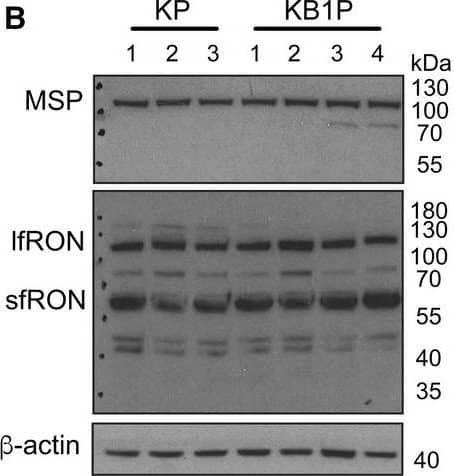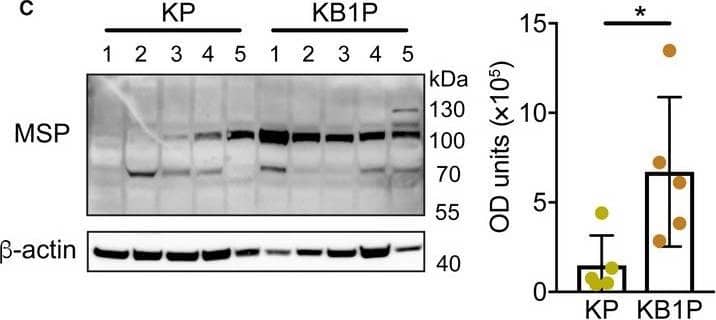Mouse MSP/MST1 Antibody Summary
Gly19-Gly716 (Cys677Ala)
Accession # NP_032269
Applications
Please Note: Optimal dilutions should be determined by each laboratory for each application. General Protocols are available in the Technical Information section on our website.
Scientific Data
 View Larger
View Larger
Detection of Mouse MSP/MST1 by Western Blot. Western blot shows lysates of mouse liver tissue. PVDF membrane was probed with 1 µg/mL of Sheep Anti-Mouse MSP/MST1 Antigen Affinity-purified Polyclonal Antibody (Catalog # AF6244) followed by HRP-conjugated Anti-Sheep IgG Secondary Antibody (Catalog # HAF016). A specific band was detected for MSP/MST1 at approximately 96 kDa (as indicated). This experiment was conducted under reducing conditions and using Immunoblot Buffer Group 8.
 View Larger
View Larger
MSP/MST1 in Mouse Liver. MSP/MST1 was detected in perfusion fixed frozen sections of mouse liver using Sheep Anti-Mouse MSP/MST1 Antigen Affinity-purified Polyclonal Antibody (Catalog # AF6244) at 15 µg/mL overnight at 4 °C. Tissue was stained using the Anti-Sheep HRP-DAB Cell & Tissue Staining Kit (brown; Catalog # CTS019) and counterstained with hematoxylin (blue). Specific staining was localized to hepatocytes. View our protocol for Chromogenic IHC Staining of Frozen Tissue Sections.
 View Larger
View Larger
Detection of Mouse MSP/MST1 by Western Blot MSP stimulates AKT and MAPK signaling pathways through the RON receptor. (A) Mst1r mRNA expression assessed by qRT–PCR in cell lines derived from three KP tumors and four KB1P tumors, respectively. (B) Western blot analysis of RON protein expression in the same cell lines used in A. beta ‐Actin was used as sample integrity control (same sample, different blot). (C) Western blot analysis of indicated proteins in the same KP and KB1P cell lines used in A, B. Cells were pretreated with 1 μm BMS‐777607 for 1 h prior to 100 ng·mL−1 recombinant MSP for 1 h where denoted. Images are representative of three replicate experiments. Total AKT and ERK were probed on the same blot as sample integrity controls. (D) Two KB1P cell lines were transduced with lentiviral shRNA vectors against Mst1r mRNA (shRON‐1 or shRON‐2) or control pLKO.1 vector. Confirmation of Mst1r mRNA knockdown quantified by qRT–PCR is expressed as relative to two housekeeping genes, Hprt and beta ‐actin (each dot represents one technical replicate in a given experiment, the experiment was repeated three times for each cell line). (E) Two independent KB1P cell lines transduced with control or shRNA vectors against Mst1r mRNA were treated with 100 ng·mL−1 recombinant MSP for 1 h. Activation of AKT and ERK1/2 was assessed by western blot. Images are representative of three replicate transduction experiments. Data are represented as mean ± SD. **P < 0.01 as determined by one‐way ANOVA followed by Dunn’s post hoc test. n.s., not significant. Image collected and cropped by CiteAb from the following publication (https://pubmed.ncbi.nlm.nih.gov/32484599), licensed under a CC-BY license. Not internally tested by R&D Systems.
 View Larger
View Larger
Detection of Mouse MSP/MST1 by Western Blot MSP and RON are upregulated in tumors from KB1P mice. (A) Mst1 and Mst1r mRNA expression in normal MG (from three individual mice), KP tumors (n = 44) and KB1P tumors (n = 41) analyzed by RNA sequencing. Boxplots represent the median, and 25th and 75th percentiles. (B) Mst1 and Mst1r mRNA expression in KP and KB1P tumors assessed by qRT–PCR (n = 7/group). (C) Western blot analysis of MSP expression in KP and KB1P tumors with densitometric quantification. Numbers above the blot represent individual tumors. Each dot represents one donor tumor from one mouse. (D) MSP serum levels in tumor‐free, WT (n = 5) mice, tumor‐bearing KP (n = 6) mice, and tumor‐bearing KB1P (n = 6) mice assessed by ELISA. (E) Western blot analysis of RON protein expression in KP and KB1P tumors (same samples as in C) with densitometric quantification. Numbers above the blot represent individual tumors. Each dot represents one donor tumor from one mouse. For C and E, beta ‐actin was used as sample integrity control (same sample, different blot). Data are represented as mean ± SD. *P < 0.05, **P < 0.01, ***P < 0.001 as determined by Mann–Whitney U‐test (A, B, C, E) or one‐way ANOVA followed by Dunn’s post hoc test (D). n.s., not significant. Image collected and cropped by CiteAb from the following publication (https://pubmed.ncbi.nlm.nih.gov/32484599), licensed under a CC-BY license. Not internally tested by R&D Systems.
Reconstitution Calculator
Preparation and Storage
- 12 months from date of receipt, -20 to -70 °C as supplied.
- 1 month, 2 to 8 °C under sterile conditions after reconstitution.
- 6 months, -20 to -70 °C under sterile conditions after reconstitution.
Background: MSP/MST1
MSP (Macrophage stimulating protein 1; also hepatocyte growth factor-like protein) is an 80-95 kDa member of the peptidase S1 family of proteins. Although it is expressed principally by hepatocytes, it can also be induced in cells such as renal tubular epithelium. MSP has multiple targets, and as such, has multiple effects. It stimulates macrophage motility and phagocytosis, promotes keratinocyte and renal tubular cell proliferation, and depresses myeloid progenitor cell replication. Mouse proMSP is 698 amino acids (aa) in length. It contains one PAN (carbohydrate-binding) site (aa 19-105), four consecutive kringle domains (110-457) and an inactive peptidase S1 region (aa 489-714). An intrachain disulfide bond exists between Cys477 and Cys593 that becomes an interchain bond following protease cleavage between Arg488 and Val489. This creates a mature heterodimer containing a 45-57 kDa alpha -chain, and a 30-35 kDa beta -chain. Mouse proMSP shares 80% and 93% aa identity with human and rat proMSP, respectively.
Product Datasheets
Citation for Mouse MSP/MST1 Antibody
R&D Systems personnel manually curate a database that contains references using R&D Systems products. The data collected includes not only links to publications in PubMed, but also provides information about sample types, species, and experimental conditions.
1 Citation: Showing 1 - 1
-
The MSP‐RON axis stimulates cancer cell growth in models of triple negative breast cancer
Authors: Rhona Millar, Anna Kilbey, Sarah‐Jane Remak, Tesa M. Severson, Sandeep Dhayade, Emma Sandilands et al.
Molecular Oncology
FAQs
No product specific FAQs exist for this product, however you may
View all Antibody FAQsReviews for Mouse MSP/MST1 Antibody
There are currently no reviews for this product. Be the first to review Mouse MSP/MST1 Antibody and earn rewards!
Have you used Mouse MSP/MST1 Antibody?
Submit a review and receive an Amazon gift card.
$25/€18/£15/$25CAN/¥75 Yuan/¥2500 Yen for a review with an image
$10/€7/£6/$10 CAD/¥70 Yuan/¥1110 Yen for a review without an image
